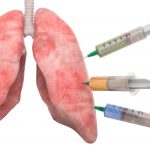Significant incidental findings in the US lung cancer screening program point to what may happen here from 2025.
One in three current or former heavy smokers who had low-dose computed tomography screening had at least one significant abnormality that was not associated with cancer, according to new research.
As Australia gets set to launch a national lung cancer screening program in July 2025, experts say clinicians need to be aware of the high chance of similar figures here and the importance of communicating to patients about the risk of incidental findings which may needed further investigation.
The US research shows that CT screening detected problems that would not have been found until participants developed symptoms at a later point, such as more advanced emphysema, blocked arteries, and abnormalities in areas other than the lungs.
The researchers found that of the significant incidental findings, 89% were abnormalities that needed to be reported to the referring doctor for follow-up.
“This represented a substantial number of findings for which further evaluation was likely needed,” they wrote in JAMA Internal Medicine.
“At the same time, it may also represent an opportunity for early intervention for clinically important extrapulmonary cancers, cardiovascular, and respiratory conditions.”
Australia’s screening program will target high-risk individuals to detect lung cancer, which killed more than 8600 Australians in 2022.
Patients will be eligible if they’re aged 50 to 70, are asymptomatic, have a history of tobacco smoking of at least 30 pack-years, and if a former smoker, have quit within the past 10 years.
Medical oncologist Dr Malinda Itchins, chair of the Clinical Oncology Society of Australia’s lung cancer group, said we could expect to see similar findings once Australia’s screening program begins.
“We expect a very similar population to be screened and all, in general practice and lung cancer specialists, need to appreciate this,” she told Health Services Daily.
“Of course, the finding of a significant incidental finding and intervention to prevent a clinical deterioration in an individual with early detection may also be a positive by-product of a screening program.”
Dr Itchins said it was important to communicate to patients that the risk of incidental findings was far higher than the risk of detecting lung cancer, and that these findings may need further investigation.
“A concerted effort will need to be made to ensure [the benefit] isn’t offset with unnecessary and potentially unsafe, anxiety provoking and expensive investigation into incidental findings not of clinical concern.
“This does not, however, negate the clear benefit of them screening.
“Overall, with the risk benefit analysis, absolutely it is fantastic we have the green light to begin screening high-risk individuals for lung cancer and to cure more formsof this deadly disease. This message cannot be lost.”
More media, public awareness and preparedness around lung cancer screening was needed in Australia, she said.
“Where has this been? Lung cancer is the biggest killer. A campaign is needed.”
Dr Itchins said the healthcare sector needed more preparation to adapt to the complexities of the screening program, which was very different to programs such as BreastScreen Australia, and to understand the protocols and how the program will run from a resourcing and staffing point of view.
With a range of significant findings that might be detected through the program, a streamlined algorithm for onward referrals was challenging, particularly in regional and rural areas, she said.
“Our lung cancer screening program needs to reach people in all corners and people must be able to access specialists to investigate other significant findings if required. General practitioners will need support.
“And the relevant healthcare community pivotal to the success of this program need to be briefed and enabled lead time to prepare.”
The program needed adequate resourcing, she said.
“There cannot be long wait lists either threatening the success of the program or investigation into incidental findings that arise within.”
Dr Itchins said specialists and radiologists in already resource-deficient public hospitals needed more training and awareness about the program rollout and how it will operate.
“Defined responsibilities and clear pathways will be paramount. Funding for more specialist positions at the backend of screening will be imperative to deal with the findings needed to follow, cancerous and non-cancerous. I am not aware this has been committed to.”
Dr Itchins said patients who volunteered or chose to enroll in the lung cancer screening program were more likely to be connected with the medical system already and have any other medical conditions detected earlier.
“We of course hope to recruit those who have not embraced the medical system into the system for screening and smoking cessation support.
“We want them to then develop rapport with this system, and not be put off by the potential over-investigation of incidental findings that have no bearing on their health and may risk their health if invasive procedures are performed when not warranted.”
The more than 26,000 participants in the US research had a history of heavy smoking – at least 30 pack years – and were screened with low-dose computed tomography as part of the US’s lung cancer screening trial.
The researchers defined “significant incident findings” as a negative screen result with significant abnormalities that were not suspicious for lung cancer, or a positive screen result with emphysema, significant cardiovascular abnormality, or significant abnormality above or below the diaphragm.
The most common significant incidental findings were emphysema (43% of all findings), coronary artery calcium (12%), and masses or suspicious lesions (7%). Masses commonly included kidney, liver, adrenal and breast abnormalities.
The researchers used data from the National Lung Screening Trial, which included more than 53,000 participants aged 55 to 74 with a smoking history of 30 pack years who were either currently smoking or had quit within the previous 15 years.
The US participants were randomly assigned to have either low-dose computed tomography or chest X-rays at baseline, and then had two more follow-up screens at one-year intervals, and were followed up for five to seven years.
The researchers found that there was a higher proportion of reportable significant incidental findings among participants with a positive screen result for lung cancer (94.1% of the incidents reported) compared with those with a negative screen result (81.8% of the incidents reported).
“Significant incidental findings were more common in participants with a screening result that was positive for lung cancer (44.7%) than for participants with a negative screen result for lung cancer (9.9%),” they said.
“However, given the many participants with a negative LDCT screen result for lung cancer (985 at three screening examinations), this is a substantial number of potentially clinically significant findings (5620).”
Lead author and epidemiologist Associate Professor Ilana Gareen from Brown University said they weren’t especially surprised that one third of participants had significant incidental findings, because they all had a history of heavy smoking.
She said patients and medical providers needed to be aware of the high likelihood of detecting significant incidental findings, which must be appropriately reported and managed.
“According to the literature, many of them would not [have been] diagnosed until they became symptomatic; that is, with more advanced emphysema or later stage cancer,” Professor Gareen told Rheumatology Republic.
“For some participants, the findings were ‘incidentalomas’ and would never be diagnosed.”
Professor Gareen said it was anticipated that some of the significant incidental findings would indicate potential future cancers.
“SIFs are an important issue in lung screening, and in all imaging. The discovery of a SIF offers the opportunity to diagnose pathological conditions early, but it also carries the risk of unnecessary medical interventions.
“It is important that evidence-based standardised approaches to reporting and evaluating these SIFs are developed,” she said.
The researchers also collected data on the participants who had X-ray screening and planned to compare their mortality to those in the LDCT group in another paper.




